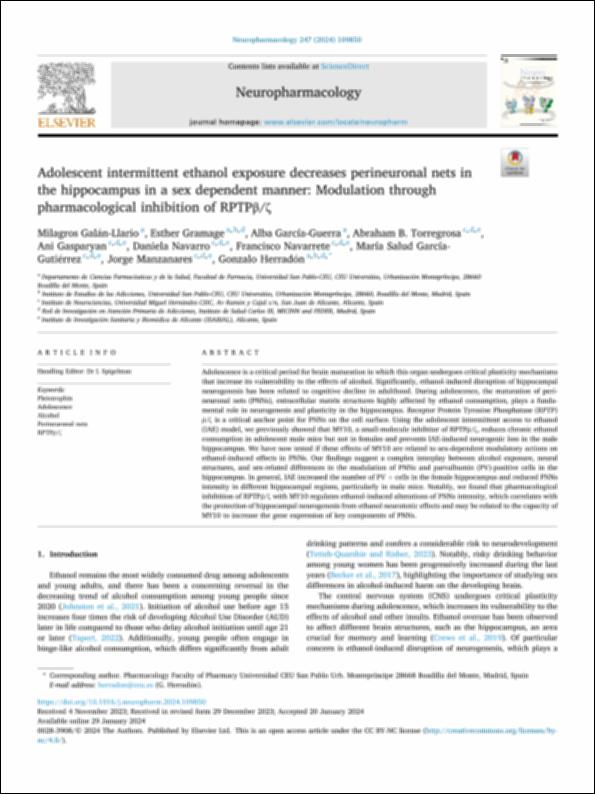Por favor, use este identificador para citar o enlazar este ítem:
http://hdl.handle.net/10637/15625Adolescent intermittent ethanol exposure decreases perineuronal nets in the hippocampus in a sex dependent manner: Modulation through pharmacological inhibition of RPTPβ/ζ
| Título : | Adolescent intermittent ethanol exposure decreases perineuronal nets in the hippocampus in a sex dependent manner: Modulation through pharmacological inhibition of RPTPβ/ζ |
| Autor : | Galán Llario, Milagros Gramage, Esther García Guerra, Alba Torregrosa, Abraham B. Gasparyan, Ani Navarro, Daniela Navarrete Rueda, Francisco García Gutiérrez, María Salud Manzanares, Jorge Herradón Gil-Gallardo, Gonzalo |
| Materias: | Pleiotrophin; Adolescence; Alcohol; Perineuronal nets; RPTPβ/ζ |
| Editorial : | Elsevier |
| Citación : | Milagros Galán-Llario, Esther Gramage, Alba García-Guerra, Abraham B. Torregrosa, Ani Gasparyan, Daniela Navarro, Francisco Navarrete, María Salud García-Gutiérrez, Jorge Manzanares, Gonzalo Herradón, Adolescent intermittent ethanol exposure decreases perineuronal nets in the hippocampus in a sex dependent manner: Modulation through pharmacological inhibition of RPTPβ/ζ, Neuropharmacology, Volume 247, 2024, 109850, ISSN 0028-3908, https://doi.org/10.1016/j.neuropharm.2024.109850 |
| Resumen : | Adolescence is a critical period for brain maturation in which this organ undergoes critical plasticity mechanisms that increase its vulnerability to the effects of alcohol. Significantly, ethanol-induced disruption of hippocampal neurogenesis has been related to cognitive decline in adulthood. During adolescence, the maturation of perineuronal nets (PNNs), extracellular matrix structures highly affected by ethanol consumption, plays a fundamental role in neurogenesis and plasticity in the hippocampus. Receptor Protein Tyrosine Phosphatase (RPTP) β/ζ is a critical anchor point for PNNs on the cell surface. Using the adolescent intermittent access to ethanol (IAE) model, we previously showed that MY10, a small-molecule inhibitor of RPTPβ/ζ, reduces chronic ethanol consumption in adolescent male mice but not in females and prevents IAE-induced neurogenic loss in the male hippocampus. We have now tested if these effects of MY10 are related to sex-dependent modulatory actions on ethanol-induced effects in PNNs. Our findings suggest a complex interplay between alcohol exposure, neural structures, and sex-related differences in the modulation of PNNs and parvalbumin (PV)-positive cells in the hippocampus. In general, IAE increased the number of PV + cells in the female hippocampus and reduced PNNs intensity in different hippocampal regions, particularly in male mice. Notably, we found that pharmacological inhibition of RPTPβ/ζ with MY10 regulates ethanol-induced alterations of PNNs intensity, which correlates with the protection of hippocampal neurogenesis from ethanol neurotoxic effects and may be related to the capacity of MY10 to increase the gene expression of key components of PNNs. |
| Descripción : | Información complementaria en https://doi. org/10.1016/j.neuropharm.2024.109850 |
| URI : | http://hdl.handle.net/10637/15625 |
| Derechos: | http://creativecommons.org/licenses/by-nc-nd/4.0/deed.es Open Access |
| ISSN : | 1873-7064 |
| Cubierto por: | Acuerdo Transformativo - 2024 |
| Fecha de publicación : | 29-ene-2024 |
| Centro : | Universidad San Pablo-CEU |
| Aparece en las colecciones: | Facultad de Farmacia |
Los ítems de DSpace están protegidos por copyright, con todos los derechos reservados, a menos que se indique lo contrario.


